A short history of Belgian Christmas beer
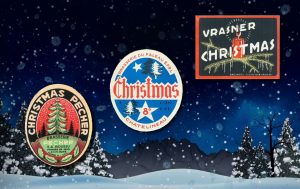 Another wonderful Belgian tradition: Christmas beer. During the darkest days of the year all those breweries present their best brews to sip sitting by the fireplace, while outside the snow keeps falling and inside little angels hang in the Christmas tree. Most Belgian Christmas beers are dark and heavy, although there are light-coloured exceptions like Avec les bons voeux by the Dupont brewery. But where does this tradition come from exactly? That’s what I wanted to find out.
Another wonderful Belgian tradition: Christmas beer. During the darkest days of the year all those breweries present their best brews to sip sitting by the fireplace, while outside the snow keeps falling and inside little angels hang in the Christmas tree. Most Belgian Christmas beers are dark and heavy, although there are light-coloured exceptions like Avec les bons voeux by the Dupont brewery. But where does this tradition come from exactly? That’s what I wanted to find out.
A while ago I attended a small internationally-themed beer event, where one of the speakers was a young Belgian brewer who would be talking about beer history. Somewhere halfway his talk he got to Christmas beer. He claimed it was conceived because in the past the quality of grains used to vary quite a lot. While waiting for the new barley harvest to become available, they would cease production of the regular beer and brew an extra heavy Christmas beer instead, to get rid of the old stocks. Or something like that.
In all honesty, I didn’t understand much of it, and I believed it even less. In all the historic literature I’ve studied I’ve never come across such a practice and Christmas beer doesn’t feature in those sources in this way. It’s not that I blame the young brewer: there’s just so much nonsense out there, and I’m sure he just heard this somewhere. But then: what is the actual deal with Belgian Christmas beer?
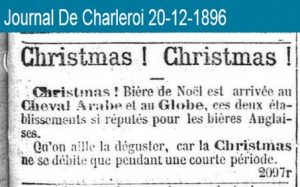 When researching in Belgium, you have no choice but to search in both the country’s main languages, Dutch and French, simultaneously. But if you type ‘kerstbier’ or ‘bière de Noël’ there’s not much you will find… because the oldest instances are in a quite different language altogether. In late December 1896 two cafés in Charleroi, Le Cheval Arabe and Le Globe, both known for their English beers, advertised their ‘Christmas! Christmas!’ Yes, the word was in English. Their patrons had to be quick, because the Christmas beer would only be available for a limited amount of time.[1]
When researching in Belgium, you have no choice but to search in both the country’s main languages, Dutch and French, simultaneously. But if you type ‘kerstbier’ or ‘bière de Noël’ there’s not much you will find… because the oldest instances are in a quite different language altogether. In late December 1896 two cafés in Charleroi, Le Cheval Arabe and Le Globe, both known for their English beers, advertised their ‘Christmas! Christmas!’ Yes, the word was in English. Their patrons had to be quick, because the Christmas beer would only be available for a limited amount of time.[1]
During the years after that, judging by the newspaper adverts, Christmas beer became a regular thing at the Cheval Arabe in Rue de la Montagne, but also at other cafés in Charleroi and elsewhere. But what was it exactly? In 1900 the Oxford Bar in Bruges advertised its ‘Double Scotch Christmas ale’ (sic, in English), while in 1901 Le Cheval Arabe made public that its ‘Christmas’ had been made by MacEwan’s brewery in Edinburgh. In 1903 one A.J. Simon in Brussels advertised ‘Christmas Beer (double Scotch Ale)’ made by W. Younger & Co in Edinburgh. And in 1911 in Liège ‘Scotch-Ale Christmas-Bier’ was on sale made by Allsopp’s from Burton-on-Trent.[2]
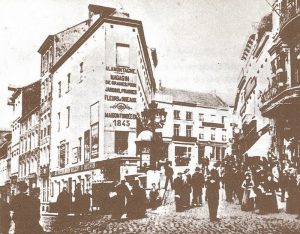 So what was Christmas beer in Belgium in those years? Imported Scotch ale from across the North Sea, heavy dark British beer. ‘Christmas folks, that’s an English beer, but you shouldn’t drink too much of it, because otherwise you’ll see the world spin in circles like a merry-go-round. (‘…ge moogt er niet veel van drinken, want anders ziet ge de wereld als een peerdekensmolen draaien.’)[3]
So what was Christmas beer in Belgium in those years? Imported Scotch ale from across the North Sea, heavy dark British beer. ‘Christmas folks, that’s an English beer, but you shouldn’t drink too much of it, because otherwise you’ll see the world spin in circles like a merry-go-round. (‘…ge moogt er niet veel van drinken, want anders ziet ge de wereld als een peerdekensmolen draaien.’)[3]
British beer was hugely popular with Belgian beer lovers. Around the year 1900 Belgian beer was often weak and brewed with old-fashioned equipment. Therefore, it was hardly ever exported (while today, over half of Belgian production is sent abroad), but there was plenty of import of British and German beer. While in 1890 about 55,000 hl of beer was imported, ten years later this was 149,000 hl, which then doubled to 317,000 hl in 1912, when about 2% of all beer consumed in Belgium was imported. The Belgians were thirsty for foreign beer and more than just a bit. About half of the import was German and the other half was British.[4]
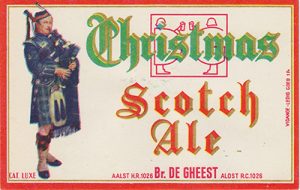 Belgian brewers panicked, importers were puzzled, like a certain Mr. Richardson, who imported Whitbread’s beer into Belgium: ‘We don’t credit advertising for our success, because the publicity we made was rather insignificant.’ No surprise then that in 1908 he opened an immense new warehouse in Brussels, where each year 600,000 bottles of English beer were filled for the Belgian market; there was room for one million and a half.[5]
Belgian brewers panicked, importers were puzzled, like a certain Mr. Richardson, who imported Whitbread’s beer into Belgium: ‘We don’t credit advertising for our success, because the publicity we made was rather insignificant.’ No surprise then that in 1908 he opened an immense new warehouse in Brussels, where each year 600,000 bottles of English beer were filled for the Belgian market; there was room for one million and a half.[5]
So Belgium imported pale ale, stout (read more) and Scotch ale. But in the UK, ‘Christmas’ was not a beer type. I verified with English beer history expert (and Zythophile) Martyn Cornell, but it’s most likely that in Belgium they simply sold Scotch Ale as Christmas beer, possibly with specially designed Christmas labels. There are a few newspaper adverts that mention Scotch and Christmas as two separate beers, but in general they must have been the same thing.[6]
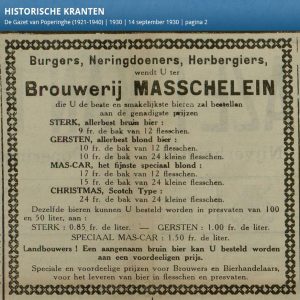 It was of course a question of time before Belgian breweries would start imitating those British products, including Christmas beer. Already in 1903, the Alfred Jadin brewery in Dampremy near Charleroi tried to sell its ‘bière triple’ as a ‘bière de Noël’, and in 1907 the Beaudrihaye brewery in Liège introduced its ‘Canterbury Christmas’.[7] Especially after the First World War brewing English beer types became a trend among Belgian brewers. After all, English beer was top-fermented and thus for smaller breweries it required less investments than making German-type beers. When looking at labels from those years, you’ll clearly see that Christmas beer was invariably sold as ‘Christmas’, that is, in English. Obviously, Christmas beer was by no means a beer of Belgian origin! (On the other hand, the story that Stella Artois lager started life as a Christmas beer, seems hard to corroborate, read the article.)
It was of course a question of time before Belgian breweries would start imitating those British products, including Christmas beer. Already in 1903, the Alfred Jadin brewery in Dampremy near Charleroi tried to sell its ‘bière triple’ as a ‘bière de Noël’, and in 1907 the Beaudrihaye brewery in Liège introduced its ‘Canterbury Christmas’.[7] Especially after the First World War brewing English beer types became a trend among Belgian brewers. After all, English beer was top-fermented and thus for smaller breweries it required less investments than making German-type beers. When looking at labels from those years, you’ll clearly see that Christmas beer was invariably sold as ‘Christmas’, that is, in English. Obviously, Christmas beer was by no means a beer of Belgian origin! (On the other hand, the story that Stella Artois lager started life as a Christmas beer, seems hard to corroborate, read the article.)
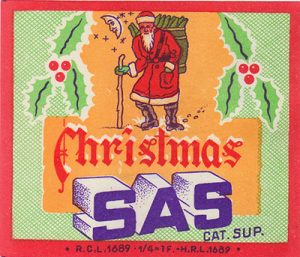 |
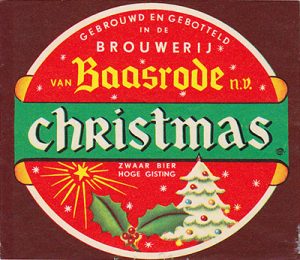 |
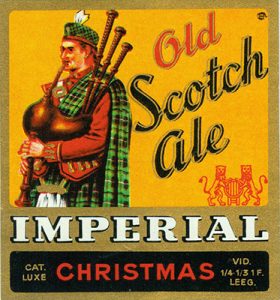 |
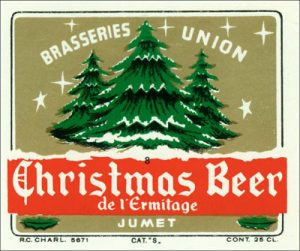 |
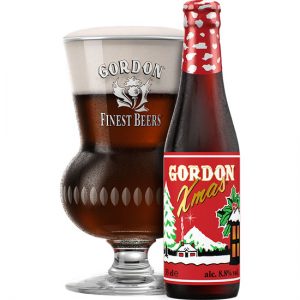 A well-known Christmas beer is Gordon X-mas, registered as a trade mark in 1934 by Anglo-Belgian importer John Martin. It still exists today, and all this time it had been made for them in Scotland, until a few years ago the Palm brewery got the gig. Clearly it wasn’t ‘the first Christmas beer’ on the continent, as has been claimed sometimes, but it surely is one of the Christmas beers that have been around for the longest time.[8]
A well-known Christmas beer is Gordon X-mas, registered as a trade mark in 1934 by Anglo-Belgian importer John Martin. It still exists today, and all this time it had been made for them in Scotland, until a few years ago the Palm brewery got the gig. Clearly it wasn’t ‘the first Christmas beer’ on the continent, as has been claimed sometimes, but it surely is one of the Christmas beers that have been around for the longest time.[8]
Today, Belgium has dozens of Christmas beers to offer; almost every self-respecting specialty brewery makes one. And although there are exceptions, most of them have stayed true to the original example of the strong brown Scotch Ales. That gnome on the N’Ice Chouffe label is wearing a kilt for a reason! It makes me think, a few of these heavy Scottish beer may have served as a model for the first dark trappist beers like Westmalle and Rochefort. And wasn’t Chimay Blue originally launched as a Christmas beer back in 1948? I’m only saying…
[1] Journal de Charleroi 20-12-1896.
[2] La Patrie 18-12-1900; Gazette de Charleroi 5-12-1901; La Meuse 12-12-1903, 18-12-1911.
[3] De Poperinghenaar 6-1-1929.
[4] Paul Godaert, Les présidents des brasseries Artois: Léon Verhelst, Henry van den Schrieck, Werner de Spoelbergh, Raymond Boon, Virton 1993, p. 24.
[5] Godaert, Les présidents des brasseries Artois, p. 25; Le petit bleu du matin 29-6-1908; Le soir 24-6-1908.
[6] For instance ‘Scotch et christmas de la célèbre brasserie Younger, d’Edimbourg’ (Gazette de Charleroi 7-2-1910) or ‘Aitchson’s Scotch ale [and] Christmas beer’ (Journal de Bruges 18-12-1921).
[7] Gazette de Charleroi 24-12-1903; La Meuse 23-12-1907.
[8] https://www.boip.int/nl/merkenregister; http://www.bierpassie.com/article/2181/het-eerste-kerstbier-op-het-continent.
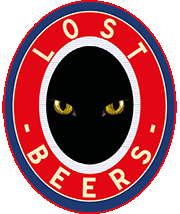





Just wondering…
Isn’t Christmas as we understand it now, with the tree, presents, etc. a Nordic/German thing, originally ? And something that spread, from the mid/late 19th Century on, first to Britain (possibly because of the strong links of Queen Victoria to Germany), and then to the Continent ?
And then, if I remember correctly, before Christmas came along that way, in many parts of the Continent, presents were not given on Christmas daym, but on new year’s day (q.v. the concept of “étrennes” in French-speaking areas), or a couple of days later (on the Epiphany, 6 January, in Spain, for example)
My point being : considering a few beers referring to the new year – such as Dupont’s Avec les Bon Voeux or Caracole’s Cuvée de l’An Neuf – still exist in Belgium, could it be that there was a previous tradition of new year’s beer in Belgium, which was merged in the first half of the 20th century with the imported Christmas thing ?
Hi Laurent,
I have never come across historical Belgian New Year’s beers, and as said, the Belgian Christmas beer tradition doesn’t go that far back either; just over a 100 years. The Belgians did not import the idea of Christmas beer from England, it’s just something they tacked onto imported British beers themselves.
Also, I’m not aware of giving away Christmas or New Year’s beers as a present.
I’m afraid you’re reading much more into all this than there actually is to be found… As far as I know, Dupont’s Avec les bons voeux dates from the late 1970s, and Caracole started brewing only in 1990.
[…] che ha ispirato successivamente quella belga, come riporta lo storico olandese Roel Mulder nel suo blog. Le Winter Warmer, birre prodotte nella stagione fredda per avere un inverno più caldo. Dato dagli […]